Zhihang Zhong
AniCrafter: Customizing Realistic Human-Centric Animation via Avatar-Background Conditioning in Video Diffusion Models
May 26, 2025Abstract:Recent advances in video diffusion models have significantly improved character animation techniques. However, current approaches rely on basic structural conditions such as DWPose or SMPL-X to animate character images, limiting their effectiveness in open-domain scenarios with dynamic backgrounds or challenging human poses. In this paper, we introduce $\textbf{AniCrafter}$, a diffusion-based human-centric animation model that can seamlessly integrate and animate a given character into open-domain dynamic backgrounds while following given human motion sequences. Built on cutting-edge Image-to-Video (I2V) diffusion architectures, our model incorporates an innovative "avatar-background" conditioning mechanism that reframes open-domain human-centric animation as a restoration task, enabling more stable and versatile animation outputs. Experimental results demonstrate the superior performance of our method. Codes will be available at https://github.com/MyNiuuu/AniCrafter.
CityGS-X: A Scalable Architecture for Efficient and Geometrically Accurate Large-Scale Scene Reconstruction
Mar 29, 2025Abstract:Despite its significant achievements in large-scale scene reconstruction, 3D Gaussian Splatting still faces substantial challenges, including slow processing, high computational costs, and limited geometric accuracy. These core issues arise from its inherently unstructured design and the absence of efficient parallelization. To overcome these challenges simultaneously, we introduce CityGS-X, a scalable architecture built on a novel parallelized hybrid hierarchical 3D representation (PH^2-3D). As an early attempt, CityGS-X abandons the cumbersome merge-and-partition process and instead adopts a newly-designed batch-level multi-task rendering process. This architecture enables efficient multi-GPU rendering through dynamic Level-of-Detail voxel allocations, significantly improving scalability and performance. Through extensive experiments, CityGS-X consistently outperforms existing methods in terms of faster training times, larger rendering capacities, and more accurate geometric details in large-scale scenes. Notably, CityGS-X can train and render a scene with 5,000+ images in just 5 hours using only 4 * 4090 GPUs, a task that would make other alternative methods encounter Out-Of-Memory (OOM) issues and fail completely. This implies that CityGS-X is far beyond the capacity of other existing methods.
R3-Avatar: Record and Retrieve Temporal Codebook for Reconstructing Photorealistic Human Avatars
Mar 17, 2025Abstract:We present R3-Avatar, incorporating a temporal codebook, to overcome the inability of human avatars to be both animatable and of high-fidelity rendering quality. Existing video-based reconstruction of 3D human avatars either focuses solely on rendering, lacking animation support, or learns a pose-appearance mapping for animating, which degrades under limited training poses or complex clothing. In this paper, we adopt a "record-retrieve-reconstruct" strategy that ensures high-quality rendering from novel views while mitigating degradation in novel poses. Specifically, disambiguating timestamps record temporal appearance variations in a codebook, ensuring high-fidelity novel-view rendering, while novel poses retrieve corresponding timestamps by matching the most similar training poses for augmented appearance. Our R3-Avatar outperforms cutting-edge video-based human avatar reconstruction, particularly in overcoming visual quality degradation in extreme scenarios with limited training human poses and complex clothing.
SGA-INTERACT: A 3D Skeleton-based Benchmark for Group Activity Understanding in Modern Basketball Tactic
Mar 09, 2025Abstract:Group Activity Understanding is predominantly studied as Group Activity Recognition (GAR) task. However, existing GAR benchmarks suffer from coarse-grained activity vocabularies and the only data form in single-view, which hinder the evaluation of state-of-the-art algorithms. To address these limitations, we introduce SGA-INTERACT, the first 3D skeleton-based benchmark for group activity understanding. It features complex activities inspired by basketball tactics, emphasizing rich spatial interactions and long-term dependencies. SGA-INTERACT introduces Temporal Group Activity Localization (TGAL) task, extending group activity understanding to untrimmed sequences, filling the gap left by GAR as a standalone task. In addition to the benchmark, we propose One2Many, a novel framework that employs a pretrained 3D skeleton backbone for unified individual feature extraction. This framework aligns with the feature extraction paradigm in RGB-based methods, enabling direct evaluation of RGB-based models on skeleton-based benchmarks. We conduct extensive evaluations on SGA-INTERACT using two skeleton-based methods, three RGB-based methods, and a proposed baseline within the One2Many framework. The general low performance of baselines highlights the benchmark's challenges, motivating advancements in group activity understanding.
MaskGaussian: Adaptive 3D Gaussian Representation from Probabilistic Masks
Dec 29, 2024Abstract:While 3D Gaussian Splatting (3DGS) has demonstrated remarkable performance in novel view synthesis and real-time rendering, the high memory consumption due to the use of millions of Gaussians limits its practicality. To mitigate this issue, improvements have been made by pruning unnecessary Gaussians, either through a hand-crafted criterion or by using learned masks. However, these methods deterministically remove Gaussians based on a snapshot of the pruning moment, leading to sub-optimized reconstruction performance from a long-term perspective. To address this issue, we introduce MaskGaussian, which models Gaussians as probabilistic entities rather than permanently removing them, and utilize them according to their probability of existence. To achieve this, we propose a masked-rasterization technique that enables unused yet probabilistically existing Gaussians to receive gradients, allowing for dynamic assessment of their contribution to the evolving scene and adjustment of their probability of existence. Hence, the importance of Gaussians iteratively changes and the pruned Gaussians are selected diversely. Extensive experiments demonstrate the superiority of the proposed method in achieving better rendering quality with fewer Gaussians than previous pruning methods, pruning over 60% of Gaussians on average with only a 0.02 PSNR decline. Our code can be found at: https://github.com/kaikai23/MaskGaussian
DIR: Retrieval-Augmented Image Captioning with Comprehensive Understanding
Dec 02, 2024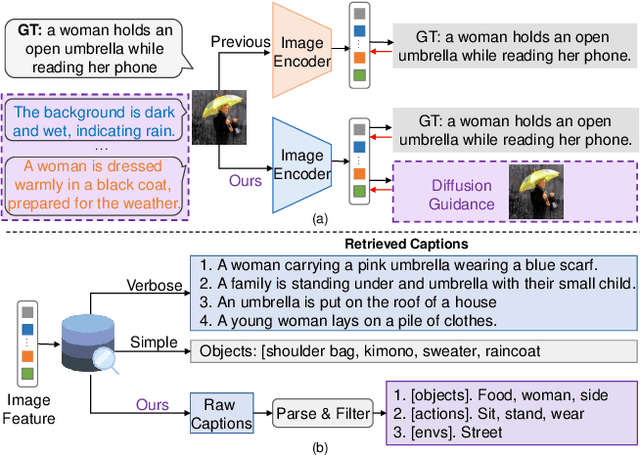
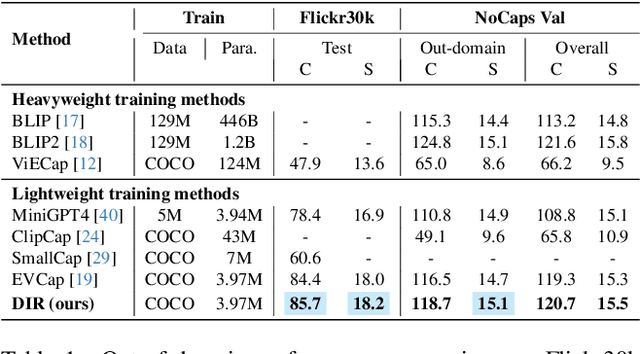


Abstract:Image captioning models often suffer from performance degradation when applied to novel datasets, as they are typically trained on domain-specific data. To enhance generalization in out-of-domain scenarios, retrieval-augmented approaches have garnered increasing attention. However, current methods face two key challenges: (1) image features used for retrieval are often optimized based on ground-truth (GT) captions, which represent the image from a specific perspective and are influenced by annotator biases, and (2) they underutilize the full potential of retrieved text, typically relying on raw captions or parsed objects, which fail to capture the full semantic richness of the data. In this paper, we propose Dive Into Retrieval (DIR), a method designed to enhance both the image-to-text retrieval process and the utilization of retrieved text to achieve a more comprehensive understanding of the visual content. Our approach introduces two key innovations: (1) diffusion-guided retrieval enhancement, where a pretrained diffusion model guides image feature learning by reconstructing noisy images, allowing the model to capture more comprehensive and fine-grained visual information beyond standard annotated captions; and (2) a high-quality retrieval database, which provides comprehensive semantic information to enhance caption generation, especially in out-of-domain scenarios. Extensive experiments demonstrate that DIR not only maintains competitive in-domain performance but also significantly improves out-of-domain generalization, all without increasing inference costs.
GAST: Sequential Gaussian Avatars with Hierarchical Spatio-temporal Context
Nov 25, 2024Abstract:3D human avatars, through the use of canonical radiance fields and per-frame observed warping, enable high-fidelity rendering and animating. However, existing methods, which rely on either spatial SMPL(-X) poses or temporal embeddings, respectively suffer from coarse rendering quality or limited animation flexibility. To address these challenges, we propose GAST, a framework that unifies 3D human modeling with 3DGS by hierarchically integrating both spatial and temporal information. Specifically, we design a sequential conditioning framework for the non-rigid warping of the human body, under whose guidance more accurate 3D Gaussians can be obtained in the observation space. Moreover, the explicit properties of Gaussians allow us to embed richer sequential information, encompassing both the coarse sequence of human poses and finer per-vertex motion details. These sequence conditions are further sampled across different temporal scales, in a coarse-to-fine manner, ensuring unbiased inputs for non-rigid warping. Experimental results demonstrate that our method combined with hierarchical spatio-temporal modeling surpasses concurrent baselines, delivering both high-quality rendering and flexible animating capabilities.
Bundle Adjusted Gaussian Avatars Deblurring
Nov 24, 2024Abstract:The development of 3D human avatars from multi-view videos represents a significant yet challenging task in the field. Recent advancements, including 3D Gaussian Splattings (3DGS), have markedly progressed this domain. Nonetheless, existing techniques necessitate the use of high-quality sharp images, which are often impractical to obtain in real-world settings due to variations in human motion speed and intensity. In this study, we attempt to explore deriving sharp intrinsic 3D human Gaussian avatars from blurry video footage in an end-to-end manner. Our approach encompasses a 3D-aware, physics-oriented model of blur formation attributable to human movement, coupled with a 3D human motion model to clarify ambiguities found in motion-induced blurry images. This methodology facilitates the concurrent learning of avatar model parameters and the refinement of sub-frame motion parameters from a coarse initialization. We have established benchmarks for this task through a synthetic dataset derived from existing multi-view captures, alongside a real-captured dataset acquired through a 360-degree synchronous hybrid-exposure camera system. Comprehensive evaluations demonstrate that our model surpasses existing baselines.
X as Supervision: Contending with Depth Ambiguity in Unsupervised Monocular 3D Pose Estimation
Nov 20, 2024Abstract:Recent unsupervised methods for monocular 3D pose estimation have endeavored to reduce dependence on limited annotated 3D data, but most are solely formulated in 2D space, overlooking the inherent depth ambiguity issue. Due to the information loss in 3D-to-2D projection, multiple potential depths may exist, yet only some of them are plausible in human structure. To tackle depth ambiguity, we propose a novel unsupervised framework featuring a multi-hypothesis detector and multiple tailored pretext tasks. The detector extracts multiple hypotheses from a heatmap within a local window, effectively managing the multi-solution problem. Furthermore, the pretext tasks harness 3D human priors from the SMPL model to regularize the solution space of pose estimation, aligning it with the empirical distribution of 3D human structures. This regularization is partially achieved through a GCN-based discriminator within the discriminative learning, and is further complemented with synthetic images through rendering, ensuring plausible estimations. Consequently, our approach demonstrates state-of-the-art unsupervised 3D pose estimation performance on various human datasets. Further evaluations on data scale-up and one animal dataset highlight its generalization capabilities. Code will be available at https://github.com/Charrrrrlie/X-as-Supervision.
ToMiE: Towards Modular Growth in Enhanced SMPL Skeleton for 3D Human with Animatable Garments
Oct 10, 2024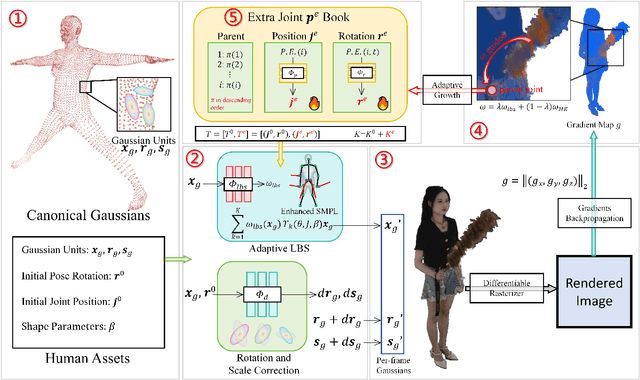

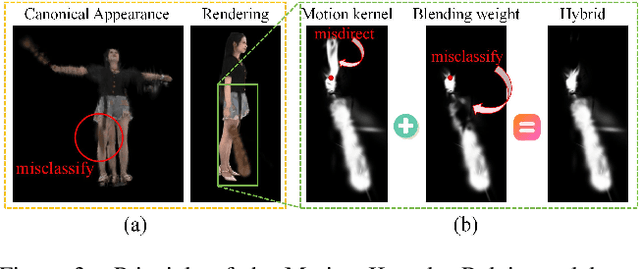
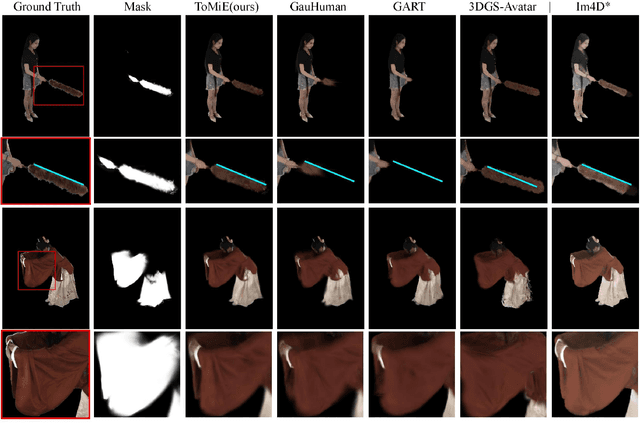
Abstract:In this paper, we highlight a critical yet often overlooked factor in most 3D human tasks, namely modeling humans with complex garments. It is known that the parameterized formulation of SMPL is able to fit human skin; while complex garments, e.g., hand-held objects and loose-fitting garments, are difficult to get modeled within the unified framework, since their movements are usually decoupled with the human body. To enhance the capability of SMPL skeleton in response to this situation, we propose a modular growth strategy that enables the joint tree of the skeleton to expand adaptively. Specifically, our method, called ToMiE, consists of parent joints localization and external joints optimization. For parent joints localization, we employ a gradient-based approach guided by both LBS blending weights and motion kernels. Once the external joints are obtained, we proceed to optimize their transformations in SE(3) across different frames, enabling rendering and explicit animation. ToMiE manages to outperform other methods across various cases with garments, not only in rendering quality but also by offering free animation of grown joints, thereby enhancing the expressive ability of SMPL skeleton for a broader range of applications.
 Add to Chrome
Add to Chrome Add to Firefox
Add to Firefox Add to Edge
Add to Edge